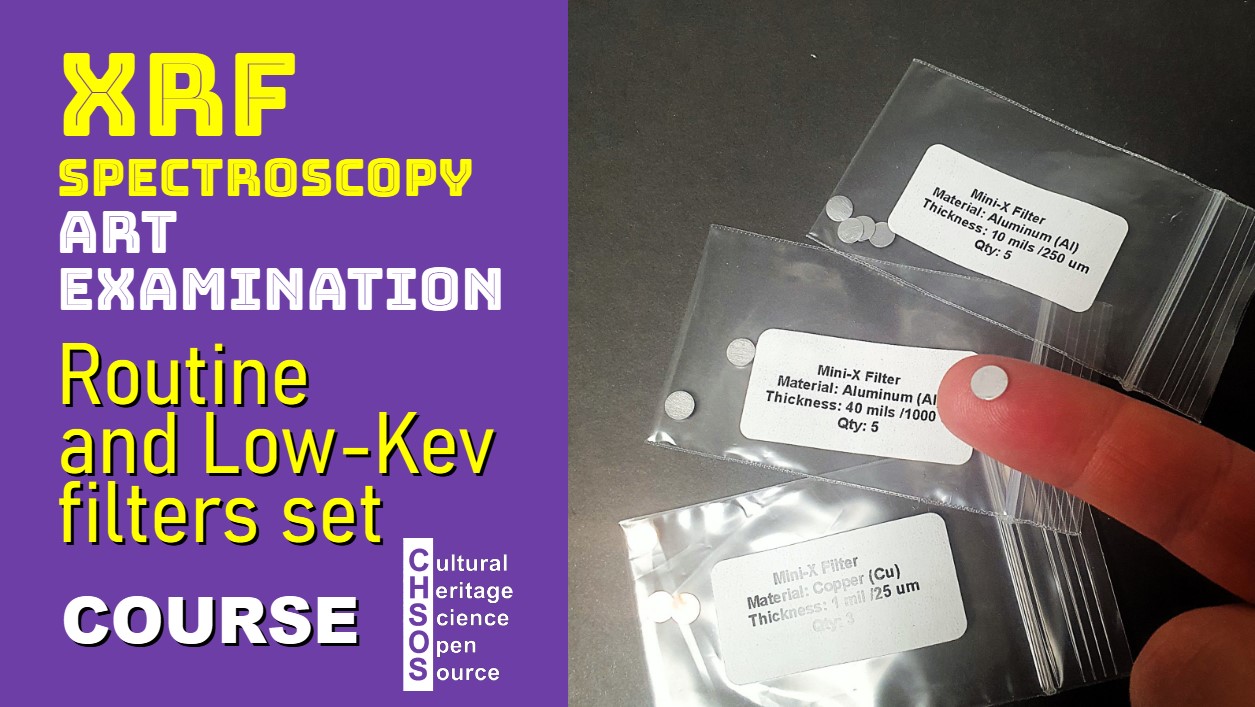
This lesson introduces filter sets used in XRF spectroscopy, focusing on optimizing X-ray tube output through various filter configurations. XRF spectroscopy relies on carefully chosen filters to analyze elemental composition, with specific filters enhancing the detection of low or high atomic number elements. This session builds on the concepts from the previous lesson, “X-ray Tube Output and Filters,” by exploring two specific filter sets designed for routine and low-energy (low-keV) XRF applications.
Objectives
- Understand the importance of using filters in XRF spectroscopy and the purpose of different filter configurations.
- Learn the characteristics and applications of two specific filter sets: the “routine” filter set and the “low-kev” filter set.
- Identify optimal filter settings for detecting elements with both high and low atomic numbers.
- Practice filter selection and observe differences in X-ray tube outputs based on filter usage.
Materials
- Routine filter set: 0.025 mm tungsten filter and 1 mm aluminum filter
- Low-kev filter set: 0.25 mm aluminum filter
- High-density polyethylene (HDPE) plate (for X-ray reflection and output observation)
- Pigments Checker, specifically gypsum and ivory black
Lesson Plan
1. Introduction to X-ray Tube Filters in XRF Spectroscopy
- Review the role of X-ray filters in enhancing element detection in XRF spectroscopy.
- Discuss the purpose of each type of filter and why materials like copper, aluminum, molybdenum, and tungsten are commonly used.
- Highlight the difference between “routine” and “low-kev” filter sets.
2. Overview of Filter Set Parameters
- Explain the consistent parameters used in both filter sets:
- Voltage set at 50 kV to excite high-energy XRF lines of heavy elements.
- Current set to 50 µA for maximum tube capacity.
- 30-second acquisition time for efficient measurement.
- Describe how the “routine” and “low-kev” filter sets differ in terms of material composition and applications.
3. Detailed Examination of the “Routine” Filter Set
- Introduce the “routine” filter set (0.025 mm tungsten and 1 mm aluminum) as a versatile choice for general analysis.
- Describe the use of this filter set in producing a flat tube output suitable for high-energy measurements, minimizing noise and irrelevant peaks.
- Demonstrate the tube output measurement without filters, followed by a measurement with the “routine” filters in place, using the HDPE plate to reflect X-rays to the spectrometer.
- Discuss the reduction in X-ray intensity with the “routine” filters and its effectiveness for detecting high-energy elements like lead and barium.
4. Overview of the “Low-kev” Filter Set for Low-Energy Applications
- Introduce the “low-kev” filter set (0.25 mm aluminum filter) designed to enhance readings below 10 keV, making it ideal for elements with low atomic numbers.
- Explain the limitations of the “low-kev” filter set for high-energy measurements, noting the presence of extraneous peaks.
5. Case Studies: Analyzing Pigments Using Different Filter Sets
- Gypsum Analysis:
- Conduct an analysis with the “routine” filter set and observe the calcium peak while noting the absence of sulfur.
- Switch to the “low-kev” filter and observe the enhanced detection of sulfur at 2 keV.
- Ivory Black Analysis:
- Explain ivory black’s composition as calcium phosphate, which contains phosphorus.
- Conduct an analysis with the “routine” filter set, noting the absence of a phosphorus peak.
- Use the “low-kev” filter and observe the emergence of the phosphorus peak, highlighting the filter’s ability to reveal low-energy elements.














